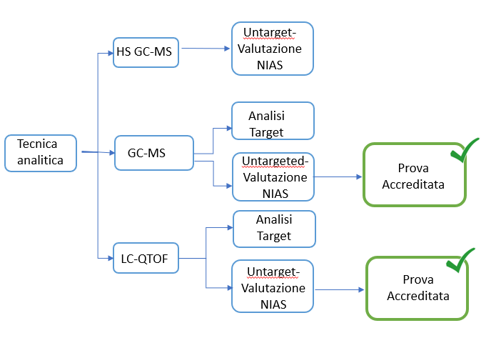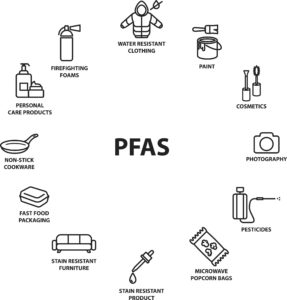TARGETED-UNTARGETED APPROACH FOR NIAS AND PFAS
TARGETED – UNTARGETED APPROACH FOR NIAS
The “TARGETED-UNTARGETED” screening approach devised by Food Contact Center, based on Dr. Vitulli’s extensive technical experience and extensive chemical knowledge, represents an important tool for detecting migrations of substances in materials in contact with food.
This approach offers the ability to identify both large and small volume migrations, based on instrumental responses.

The screening tests conducted by the laboratory involve a series of multiple analytical techinques, each designed to detect specific categories of substances. This is particularly important due to the different chemical nature of the substances involved.
The main analytical techniques used include:
- HS-GC MS (Headspace Gas Chromatography-Mass Spectrometry): this technique is used to identify and quantify the volatile compounds present in materials in contact with food.
- GC MS (Gas Chromatography- Mass Spectometry): this technique is able to detect and analyze both volatile and semi-volatile compounds, thus contributing to a comprehensive assessment of migrations.
- LC Q TOF (Liquid Chromatography Quadrupole Time-of-Flight Mass Spectrometry): This technique is used to identify and quantify non-volatile and polar compounds, both in positive and negative modes.
The use of these different analytical techniques allows a complete coverage of the possible migrations of substances in materials in contact with food.
Furthermore, the approach relies on specific compound libraries developed internally by the laboratory in collaboration with SCIEX.
In conclusion, the Food Contact Center “TARGETED UNTARGETED” screening approach represents an advance and comprehensive method to identify and quantify restricted substances not intentionally added (NIAS) in food contact materials.
This approach reflects the laboratory’s commitment to ensuring the safety and compliance of products intended for food contact.
TARGETED-UNTARGETED APPROACH IN PFAS
Perfluorinated or polyfluorinated alkyd substances (PFAS) represent a class of chemical compounds that contain fluorine atoms and are widely used in various industrial and consumer sectors due to their unique properties, such as resistance to high temperatures and the ability to make materials impermeable to grease and water.
However, their use has to led to a diffusion of these substances in the environment, with significant consequences on human and environmental health.
Major concerns related to PFAS include:
- Persistance and mobility: PFAS are known for their persistance in the environment. Furthermore, they are highly mobile in water and can pollute water resources.
- Accumulation in tissues: due to their persistance and mobility, PFAS can accumulate in the tissues of humans, animals and plants. This can lead to significant concentrations in living organisms, with potential adverse health effects.
- Impact on health: Prolonged exposure to PFAS has been associated with health problems, including weakened immune systems, liver damage, hormonal disruptions, and more.
- Evolving Regulations: Due to safety concerns, regulations regarding PFAS limits in food and other products are constantly evolving.

Given the sive of the PFAS class, wich includes more than 10.000 substances, a “TARGETED” approach alone may not be sufficient to identify all possible PFAS present in food contact materials. Therefore, Food Contact Center has adopted an “UNTARGETED” screening approach. This broader approach allows you to identify not only known substances but also new variants or unexpected contaminants.
In conclusion, Food Contact Center has developed a library of over 10.000 fluorinated molecules to adress PFAS challenges. This reflect the laboratory’s commitment to ensuring food safety in a context where regulation and understanding of PFAS are constantly evolving. The combined use of TARGETED and UNTARGETED approaches allows for a more complete and accurate assessment of PFAS in food contact materials.
